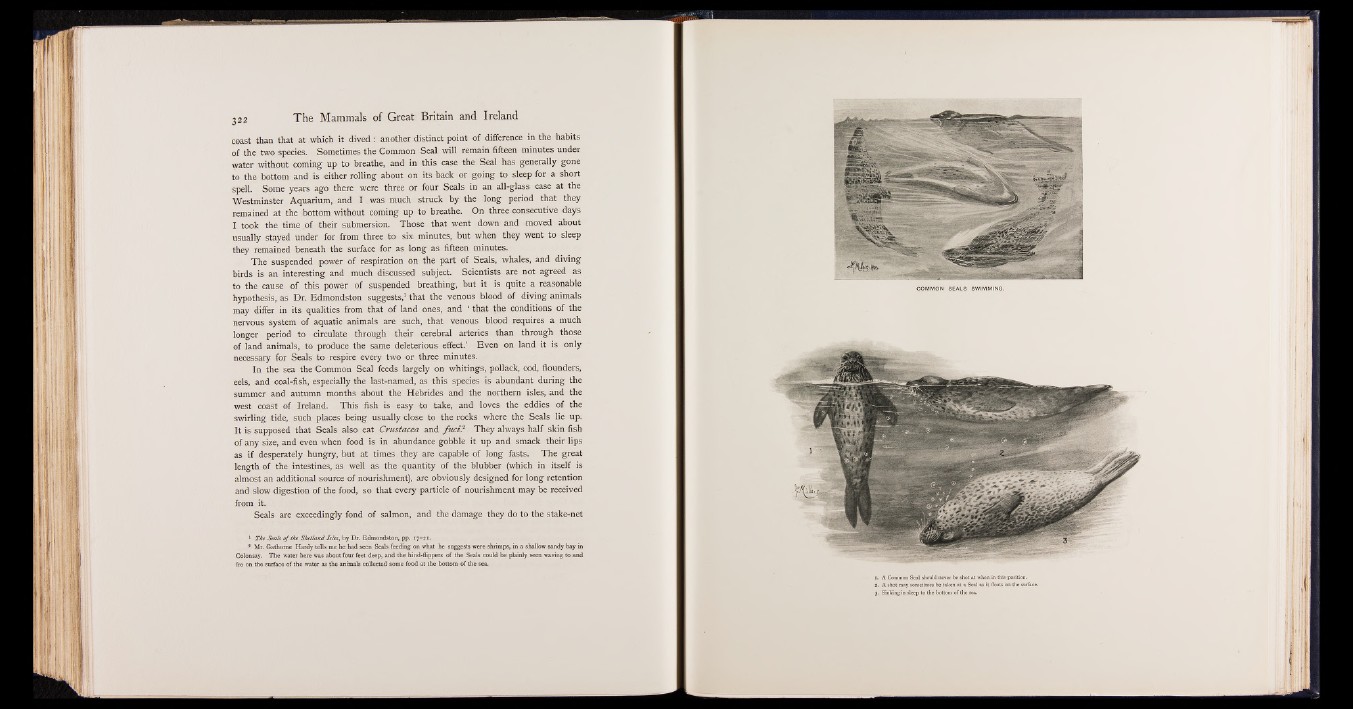
coast than that at which it dived: another distinct point of difference in the habits
of the two species. Sometimes the Common Seal will remain fifteen minutes under
water without coming up to breathe, and in this case the Seal has generally gone
to the bottom and is either rolling about on its back or going to sleep for a short
spell. Some years ago there were three or four Seals in an all-glass case at the
Westminster Aquarium, and I was much struck by the long period that they
remained at the bottom without coming up to breathe. On three consecutive days
I took the time of their submersion. Those that went down and moved about
usually stayed under for from three to six minutes, but when they went to sleep
they remained beneath the surface for as long as fifteen minutes.
The suspended power of respiration on the part of Seals, whales, and diving
birds is an interesting and much discussed subject. Scientists are not agreed as
to the cause of this power of suspended breathing, but it is quite a reasonable
hypothesis, as Dr. Edmondston suggests,1 that the venous blood of diving animals
may differ in its qualities from that of land ones, and * that the conditions of the
nervous system of aquatic animals are such, that venous blood requires a much
longer period to circulate through their cerebral arteries than through those
of land animals, to produce the same deleterious effect.’ Even on land it is only
necessary for Seals to respire every two or three minutes.
In the sea the Common Seal feeds largely on whitings, pollack, cod, flounders,
eels, and coal-fish, especially the last-named, as this species is abundant during the
summer and autumn months about the Hebrides and the northern isles, and the
west coast of Ireland. This fish is easy to take, and loves the eddies of the
swirling tide, such places being usually close to the rocks where the Seals lie up.
It is supposed that Seals also eat Crustacea and fu ci? They always half skin fish
of any size, and even when food is in abundance gobble it up and smack their lips
as if desperately hungry, but at times they are capable of long fasts. The great
length of the intestines, as well as the quantity of the blubber (which in itself is
almost an additional source of nourishment), are obviously designed for long retention
and slow digestion of the food, so that every particle of nourishment may be received
from it.
Seals are exceedingly fond of salmon, and the damage they do to the stake-net
1 The Seals of the Shetland Isles, by Dr. Edmondston, pp. 17-21.
* Mr. Gathome Hardy tells me he had seen Seals feeding on what he suggests were shrimps, in a shallow sandy bay in
Colonsay. The water here was about four feet deep, and the hind-flippers of the Seals could be plainly seen waving to and
fro on the surface of the water as die animals collected some food at the bottom of the sea.